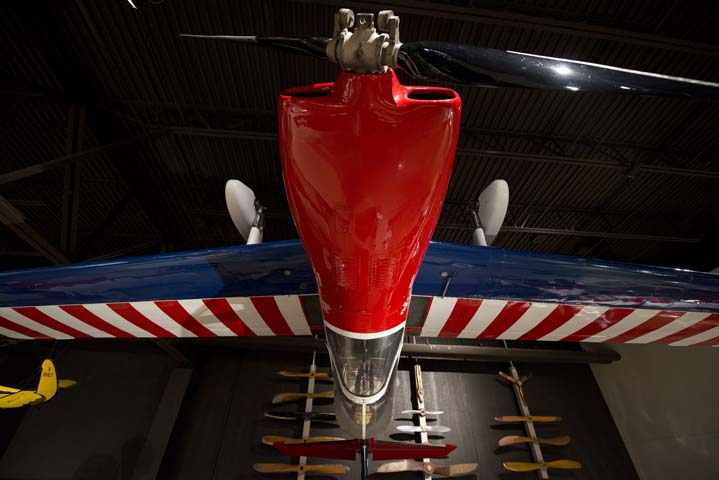1950 de Havilland DHC-1B-2 Chipmunk - N1114V
Location: Air Racing & Aerobatics
The Art Scholl Chipmunk, serial No. 116-154, was built as a DHC-1 at the de Havilland Canada factory in the Downsview area of Toronto as part of an order by the Canadian Department of National Defence. This particular aircraft was first flown by legendary test pilot George Neal on August 29, 1950, and was earmarked for the Royal Canadian Air Force (RCAF) reserve pilots and instructors program, which enabled civilian flying clubs to train pilots. It was registered as CF-CXL and delivered to the Winnipeg Flying Club in October 1950.
With the expiration of the RCAF program in late 1957, the aircraft was placed on the inactive reserve list and placed in storage until offered for sale in June 1961. In October of that year, it was purchased by the Winnipeg Flying Club and later certificated as airworthy. It was sold twice before being purchased by Sabre Industries of Winnipeg, in January 1967, for Robert “Skip” Volk of Aqua Craft Boat Company of Laverne, California.
Skip Volk, a successful boat designer, builder and championship racer, was a friend of well-known aerobatic pilot Art Scholl. Art had introduced Skip to flying, coached him in aerobatics and encouraged him (with a possible Pennzoil sponsorship) to embark upon a career in exhibition flying.
Work to modify the aircraft for exhibition flying was started soon after it arrived from Canada. Modifications are believed to have been done by Roy Sprague of Alcan Aluminum who had worked with Scholl in development of Super Chipmunks N13A and N13Y and Harold Krier’s N6311V. Sprague was assisted by Larry Riggs.
During 1969, an aerobatic duet routine evolved with Art and his famous Pennzoil Super Chipmunk N13Y and Skip piloting N1114V. They became a regular air show feature and thrilled the crowds at Brackett Field and other California air shows during the season.
By late February 1970, with a total time of 3,261 hours, the aircraft was further modified by Harry Dellicker of Del-Air at Strathmore, California, and classified as Experimental Exhibition. The partnership with Art Scholl came to a tragic end with the untimely death of Skip Volk at age 42 on May 10, 1972, while practicing for an air show. N1114V was then sold to Bill Richards of Palo Alto, California, who flew it in local aerobatic competitions bringing the total time to 4,123 hours by December 1976.
In early 1977, Art Scholl persuaded Bill Richards to part with N1114V for a new aerobatic routine. Still painted in the early 1970s color scheme of blue stars and a sunburst effect, Scholl fitted the airplane with a red, white, and blue wingtip and tail smoke system. The control stick received a three-inch extension for greater control during extreme aerobatic maneuvers and the airplane completed the 1977 air show season in this form.
For 1978, the title Super Chipmunk, Pennzoil sponsorship logos, and other marking were added to the aircraft’s paint scheme. Avionics systems were upgraded for cross-country navigation and a Christen aerobatic fuel system and new front cockpit instruments were installed.
It was a typically busy air show season for Art and N1114V in 1978. Between March and July, they were in Tulsa, Memphis, Macon, and Kissimmee. Some engine overheating problems are noted in the logs and additional cowling vents were fitted while in Florida. Art Scholl and his Super Chipmunk were often accompanied by his dog, Aileron. Sitting behind Scholl during the act, Aileron would walk out on the wing as they taxied in and jump onto Art’s shoulder when he exited the cockpit. Art’s routine was described in programs as “wild lomcevaks coupled with pyrotechnic spectaculars with a grand finale standing out on the wing waving to the crowd.”
There were no bookings for the Super Chipmunk in 1985. This may have been due to Art’s using his Pitts Special, N13AS, which was outfitted as a camera ship for film work. It was September 16, 1985, when Art and the Pitts were lost after the aircraft failed to recover from an inverted spin while filming for the movie Top Gun. Neither pilot nor aircraft were recovered from the Pacific Ocean.
Art’s widow, Judy Scholl, elected to donate his remaining aircraft to museums. Chipmunk N13Y went to the National Air and Space Museum in Washington, D.C., and N1114V to the EAA AirVenture Museum. Kevin Killingworth and Kevin Kammer, Art’s chief mechanic, delivered it to Oshkosh on June 12, 1987 with 5,183.5 total hours on the tach. The ferry flight from Rialto, California, to Oshkosh via Albuquerque, New Mexico, and La Crosse, Wisconsin, took 13 and a half hours. Their arrival was highlighted by the operation of the three-color smoke system for the last time.
Befitting the aerobatic and air show careers of both the aircraft and Art Scholl, N1114V is displayed inverted performing a ribbon cutting maneuver.
Length: 25 feet, 5 inches
Wingspan (clipped): 31 feet, 4 inches
Height: 7 feet
Empty Weight: 1,430 pounds
Gross Weight: 2,056 pounds
Crew: 2
Powerplant: Lycoming GO-435
Horsepower: 260 hp
Maximum Speed: 168 mph
Cruise Speed: 150 mph
Range: 450 miles




